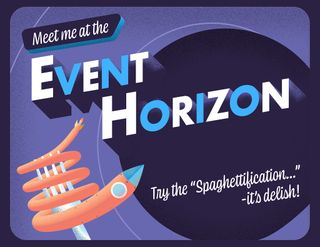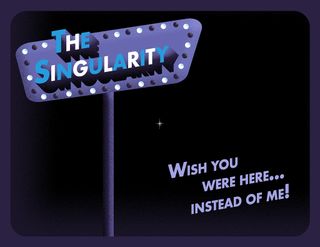Dream of Visiting a Black Hole? Maybe Don't, Fun NASA Video Suggests
NASA shared a video and a series of fun, informative postcards about black holes.
If you've ever thought about what it might be like to visit a black hole, NASA has shared a few videos and postcards that may have you reconsidering.
Black holes are among the most fascinating objects in outer space. They are extremely dense and have incredibly strong gravitational forces, meaning they pull in anything that gets too close.
NASA's Black Hole Safety video explains what a black hole is, how to find one and a safe distance to keep from falling into one — a boundary known as the event horizon, beyond which nothing can return.
Related: Black Holes of the Universe (Gallery)

"A black hole is a physical object in space, just like everything else," the video explains. "It's made up of a tiny but massive point where gravity and density are infinite, a line beyond which everything, including light, can only fall into that tiny point."
NASA's event horizon postcard warns travelers about visiting a black hole with a nod to "spaghettification," also called the noodle effect. The closer an object gets to a black hole, the stronger its gravitational pull becomes. Spaghettification refers to the vertical stretching and horizontal compression of objects that fall into a black hole.

While the event horizon of a black hole is considered the boundary around the mouth of the black hole, the inner region of a black hole is known as singularity. It is the single point in space-time where the mass of the black hole is concentrated.
Get the Space.com Newsletter
Breaking space news, the latest updates on rocket launches, skywatching events and more!
One of the postcards from NASA's black hole collection showcases the singularity as one of the most extreme vacation spots with the message: "Wish you were here … Instead of me," suggesting the singularity shouldn't be on any black-hole vacationer's bucket list.

The video also features an animated muscle-building, "king size" black hole and baby, "fun size" black hole to highlight the difference between supermassive black holes and smaller, stellar-mass black holes.
While supermassive black holes are believed to lie at the center of most galaxies, scientists are still unsure exactly how they form. Stellar black holes, on the other hand, form when a larger star collapses in on itself and begins to consume the surrounding dust and gas, also known as an accretion disk. When material falls toward a black hole, it heats up and begins to glow — which, the video says, is a telltale clue one should look for when searching for a black hole.
You can view NASA's black hole postcards online. You can also download a helpful brochure full of tips and tricks for a safe black hole vacation.
- This Tiny Galaxy Has a Pretty Big Black Hole
- Black Hole Quiz: How Well Do You Know Nature's Weirdest Creations?
- Where Do Black Holes Lead?
Follow Samantha Mathewson @Sam_Ashley13. Follow us on Twitter @Spacedotcom and on Facebook.
Join our Space Forums to keep talking space on the latest missions, night sky and more! And if you have a news tip, correction or comment, let us know at: community@space.com.

Samantha Mathewson joined Space.com as an intern in the summer of 2016. She received a B.A. in Journalism and Environmental Science at the University of New Haven, in Connecticut. Previously, her work has been published in Nature World News. When not writing or reading about science, Samantha enjoys traveling to new places and taking photos! You can follow her on Twitter @Sam_Ashley13.
